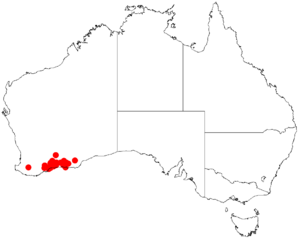Acacia dermatophylla facts for kids
Quick facts for kids Acacia dermatophylla |
|
|---|---|
| Scientific classification | |
| Genus: |
Acacia
|
| Species: |
dermatophylla
|
 |
|
| Occurrence data from AVH | |
| Synonyms | |
|
|
Acacia dermatophylla is a type of shrub (a small, bushy plant) that belongs to the Acacia family. It grows naturally only in the southern parts of Western Australia. This means it's an endemic plant, found nowhere else in the world!
What Does It Look Like?
This Acacia is a slender, single-stemmed shrub. It usually grows to be about 0.2 to 1.2 metres (1 to 4 ft) tall. Its branches are smooth, meaning they have no hairs. It has thick, upright stipules, which are small leaf-like parts at the base of the leaf stalks. These stipules are about 4 to 8 mm (0.16 to 0.31 in) long and stay on the plant.
The plant's leaves are actually called phyllodes. These are flattened leaf stalks that look and act like leaves. They are evergreen, meaning they stay green all year. The phyllodes are usually shaped like a narrow oval, wider at the top. They are about 2 to 5.5 cm (0.79 to 2.17 in) long and 4 to 23 mm (0.16 to 0.91 in) wide. You can easily see a clear vein down the middle and along the edges.
Acacia dermatophylla produces bright yellow flowers. It blooms during the cooler months, from July to October.
How It Was Named
This plant was first officially described by a botanist named George Bentham. He wrote about it in 1864 in his important work called Flora Australiensis.
Later, in 2003, another botanist named Leslie Pedley reclassified it. He moved it to a different group called Racosperma dermatophyllum. But then, in 2006, it was moved back to the Acacia genus, where it is known today.
Where It Grows
Acacia dermatophylla is found in several regions of Western Australia. These include the Wheatbelt, Goldfields-Esperance, and Great Southern areas.
You can find this plant growing from Lake Grace in the west all the way past Esperance in the east. It prefers gently rolling plains and low-lying areas. This includes places near salt flats. It grows well in sandy, loamy, or clay soils. It is often found as part of tall heath or mallee plant communities.

